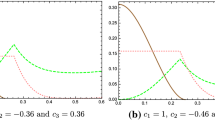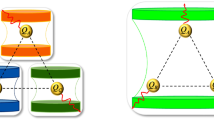Abstract
We employ the concepts of local quantum uncertainty and geometric quantum discord based on the trace norm to investigate the environmental effects on quantum correlations of two bipartite quantum systems. The first one concerns a two-qubit system coupled with two independent bosonic reservoirs. We show that the trace discord exhibits frozen phenomenon contrarily to local quantum uncertainty. The second scenario deals with a two-level system, initially prepared in a separable state, interacting with a quantized electromagnetic radiation. Our results show that there exists an exchange of quantum correlations between the two-level system and its surrounding which is responsible for the revival phenomenon of non-classical correlations.











Similar content being viewed by others
References
Nielsen, M.A., Chuang, I.L.: Quantum Computation and Quantum Information. Cambridge University Press, Cambridge (2000)
Braunstein, S.L., Kimble, H.J.: Phys. Rev. Lett. 80, 869 (1998)
Bouwmeester, D., Pan, J.W., Mattle, K., Eibl, M., Weinfurter, H., Zeilinger, A.: Nature 390, 575 (1997)
Bennett, C.H., Brassard, G.: In: The Proceedings of IEEE International Conference on Computers, Systems and Signal Processing, Bangalore, India (IEEE, New York), p. 175 (1984)
Vedral, V.: Rev. Mod. Phys. 74, 197 (2002)
Horodecki, R., Horodecki, P., Horodecki, M., Horodecki, K.: Rev. Mod. Phys. 81, 865 (2009)
Gühne, O., Tóth, G.: Phys. Rep. 474, 1 (2009)
Modi, K., Brodutch, A., Cable, H., Paterek, T., Vedral, V.: Rev. Mod. Phys. 84, 1655 (2012)
Wootters, W.K.: Phys. Rev. Lett. 80, 2245 (1998)
Ollivier, H., Zurek, W.H.: Phys. Rev. Lett. 88, 017901 (2001)
Henderson, L., Vedral, V.: J. Phys. A 34, 6899 (2001)
Huang, Y.: New J. Phys. 16, 033027 (2014)
Dakić, B., Vedral, V., Brukner, Č.: Phys. Rev. Lett. 105, 190502 (2010)
Bellomo, B., Lo Franco, R., Compagno, G.: Phys. Rev. A 86, 012312 (2012)
Bellomo, B., Giorgi, G.L., Galve, F., Lo Franco, R., Compagno, G., Zambrini, R.: Phys. Rev. A 85, 032104 (2012)
Daoud, M., Ahl Laamara, R.: Phys. Lett. A 376, 2361 (2012)
Daoud, M., Ahl Laamara, R.: Int. J. Quantum Inf. 10, 1250060 (2012)
Piani, M.: Phys. Rev. A 86, 034101 (2012)
Paula, F.M., de Oliveira, T.R., Sarandy, M.S.: Phys. Rev. A 87, 064101 (2013)
Paula, F.M., Montealegre, J.D., Saguia, A., de Oliveira, T.R., Sarandy, M.S.: EPL 103, 50008 (2013)
Bromley, T.R., Cianciaruso, M., Lo Franco, R., Adesso, G.: J. Phys. A Math. Theor. 47, 405302 (2014)
Ciccarello, F., Tufarelli, T., Giovannetti, V.: New J. Phys. 16, 013038 (2014)
Girolami, D., Tufarelli, T., Adesso, G.: Phys. Rev. Lett. 110, 240402 (2013)
Wigner, E.P., Yanasse, M.M.: Proc. Nat. Acad. Sci. U.S.A. 49, 910 (1963)
Luo, S.: Phys. Rev. Lett. 91, 180403 (2003)
Petz, D., Ghinea, C.: In: Rebolledo, R., Orszag, M. (eds.) Quantum Probability and Related Topics. World Scientific, Singapore (2011)
Luo, S.: Proc. Am. Math. Soc. 132, 885 (2003)
Girolami, D., Tufarelli, T., Adesso, G.: Phys. Rev. Lett. 110, 240402 (2013)
Nakano, T., Piani, M., Adesso, G.: Phys. Rev. A 88, 012117 (2013)
Liu, L., Zhang, J., Cheng, S., Tong, D.: J. Phys. Soc. Jpn. 82, 0640002 (2013)
Hao, X.N., Hou, J.C., Li, J.Q.: Quantum Inf. Process. 15, 2819 (2016)
Ferraro, E., Scala, M., Migliore, R., Napoli, A.: Non-Markovian dissipative dynamics of two coupled qubits in independent reservoirs: Comparison between exact solutions and master-equation approaches. Phys. Rev. A 80, 042112 (2009)
Scala, M., Migliore, R., Messina, A.: J. Phys. A Math. Theor. 41, 435304 (2008)
Agarwal, G.: Quantum Statistical Theories of Spontaneous Emission and Their Relation to Other Approaches, vol. 70 of Springer Tracts in Modern Physics. Springer, Berlin (1974)
Tanaś, R., Ficek, Z.: J. Opt. B Quantum Semiclassical Opt. 6, S90 (2004)
Ficek, Z., Tanaś, R., Kielich, S.: Phys. A 146, 452 (1987)
Auyuanet, A., Davidovich, L.: Phys. Rev. A 82, 032112 (2010)
Author information
Authors and Affiliations
Corresponding author
Appendices
Appendices
1.1 Appendix 1
The eigenvalues corresponding to this matrix \(\rho \) (5) are given by
where
The square root of the density matrix \(\rho \) can be written in terms of the matrix elements \(\rho \), in the computational basis, as follows:
The eigenvalues \(\sqrt{{\lambda _1}} \), \(\sqrt{{\lambda _2}} \),\(\sqrt{{\lambda _3}} \) and \(\sqrt{{\lambda _4}} \) of the matrix \(\sqrt{\rho }\) can be rewritten as:
The matrix \(\sqrt{\rho }\) is written in the Fano–Bloch representation as:
where \(\chi ,\delta = 0,1,2,3\) and the Fano–Bloch parameters are defined by: \({\mathcal {R}_{\chi \delta }} = \mathrm{Tr}\left( {\sqrt{\rho }{\sigma _\chi } \otimes {\sigma _\delta }} \right) \). The vanishing correlation parameters \({\mathcal {R}_{\chi \delta }}\) are given by:
1.2 Appendix 2
In this appendix, we give the expressions of the \(\gamma \left( t \right) \) function for sub-ohmic, ohmic and super-ohmic reservoirs [30].
1.2.1 (i) Sub-ohmic reservoirs
The sub-ohmic regime corresponds to the situation where \(0< s < 1\). In this case, the function \(\gamma \left( t \right) \) reads as [30]
where \({\varGamma \left( s \right) }\) denotes the Gamma function. To study the evolution of the local quantum uncertainty, one should calculate the time derivative of the function \(\gamma \left( t \right) \) . It is given by
1.2.2 (ii) Ohmic reservoirs
For reservoirs of ohmic type \((s = 1)\), the low-frequency behavior of the function \(J\left( \omega \right) \) is linear in terms of \(\omega \). The Eq. (29) becomes [30]
The time derivative of the function \(\gamma \left( t \right) \) is given by
1.2.3 (iii) Super-ohmic reservoirs
For super-ohmic reservoirs \((s > 1)\), the function \(\gamma \left( t \right) \) reads as [30]
and the derivative of \(\gamma \left( t \right) \) with respect to time t is given by
Due to the complicated expression of \(\gamma \left( t \right) \) and to simplify our numerical calculations, we have chosen the situation where \(1 < s \le 2\) and the temperature equals zero. In this case case, the function \(\gamma \left( t \right) \) becomes
Rights and permissions
About this article
Cite this article
Slaoui, A., Daoud, M. & Laamara, R.A. The dynamics of local quantum uncertainty and trace distance discord for two-qubit X states under decoherence: a comparative study. Quantum Inf Process 17, 178 (2018). https://doi.org/10.1007/s11128-018-1942-6
Received:
Accepted:
Published:
DOI: https://doi.org/10.1007/s11128-018-1942-6




